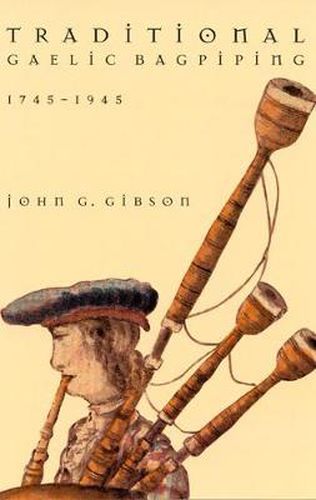Readings Newsletter
Become a Readings Member to make your shopping experience even easier.
Sign in or sign up for free!
You’re not far away from qualifying for FREE standard shipping within Australia
You’ve qualified for FREE standard shipping within Australia
The cart is loading…






The bagpipe is one of the cultural icons of Scottish highlanders, but in the 20th century traditional Scottish Gaelic piping has all but disappeared. Few recordings were ever made of traditional pipe music and there are almost no Gaelic-speaking pipers of the old school left. Recording an important aspect of Gaelic culture before it dispapeares, John Gibson chronicles the decline of traditional Highland Gaelic bagpiping - and Gaelic culture as a whole - and provides examples of traditional bagpipe music that have survived in the New World. Pulling together what is known of 18th-century West Highland piping and pipers and relating this to the effects of changing social conditions on traditional Scottish Gaelic piping since the suppression of the last Jacobite rebellion, Gibson presents a new interpretation of the decline of Gaelic piping and a new view of Gaelic society prior to the Highland diaspora. Refuting widely accepted opinions that after Culloden pipes and pipers were effectively banned in Scotland by the Disarming Act (1746), Gibson reveals that traditional dance bagpiping continued at least to the mid-19th century. He argues that the dramatic depopulation of the Highlands in the 19th century was one of the main reasons for the decline of piping. Following the path of Scottish emigrants, Gibson traces the history of bagpiping in the New World and uncovers examples of late 18th-century traditional bagpiping and dance in Gaelic Cape Breton, Nova Scotia. He argues that these anachronistic cultural forms provide a vital link to the vanished folk music and culture of the Scottish highlanders. This definitive study throws light on the ways pipers and piping contributed to social integration in the days of the clan system and on the decline in Scottish Caelic culture following the abolition of clans. It also illuminates the cultural problems faced by all ethnic minorities assimilated into unitary multinational societies.
$9.00 standard shipping within Australia
FREE standard shipping within Australia for orders over $100.00
Express & International shipping calculated at checkout
The bagpipe is one of the cultural icons of Scottish highlanders, but in the 20th century traditional Scottish Gaelic piping has all but disappeared. Few recordings were ever made of traditional pipe music and there are almost no Gaelic-speaking pipers of the old school left. Recording an important aspect of Gaelic culture before it dispapeares, John Gibson chronicles the decline of traditional Highland Gaelic bagpiping - and Gaelic culture as a whole - and provides examples of traditional bagpipe music that have survived in the New World. Pulling together what is known of 18th-century West Highland piping and pipers and relating this to the effects of changing social conditions on traditional Scottish Gaelic piping since the suppression of the last Jacobite rebellion, Gibson presents a new interpretation of the decline of Gaelic piping and a new view of Gaelic society prior to the Highland diaspora. Refuting widely accepted opinions that after Culloden pipes and pipers were effectively banned in Scotland by the Disarming Act (1746), Gibson reveals that traditional dance bagpiping continued at least to the mid-19th century. He argues that the dramatic depopulation of the Highlands in the 19th century was one of the main reasons for the decline of piping. Following the path of Scottish emigrants, Gibson traces the history of bagpiping in the New World and uncovers examples of late 18th-century traditional bagpiping and dance in Gaelic Cape Breton, Nova Scotia. He argues that these anachronistic cultural forms provide a vital link to the vanished folk music and culture of the Scottish highlanders. This definitive study throws light on the ways pipers and piping contributed to social integration in the days of the clan system and on the decline in Scottish Caelic culture following the abolition of clans. It also illuminates the cultural problems faced by all ethnic minorities assimilated into unitary multinational societies.